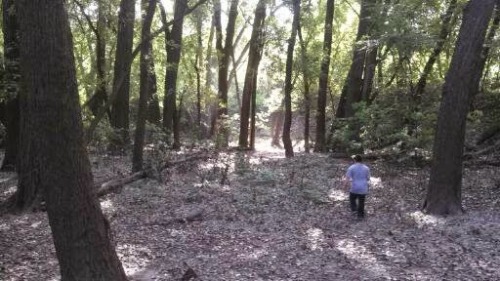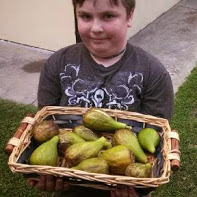
Here are the apples – L-R – Rubinette, Baker’s Square, Golden Delicious, Steele Red, Wickson, Goldrush, Library, Honey Gold, Haralson
2013 saw a lot of successful gardening and foraging projects, and none were quite as fun to participate in as the apple harvest has been. Not only did one of our trees begin to reach its full potential this year (the Haralson), we also added close to 25 new varieties to our ever growing (but still small urban orchard), harvested multiple varieties from Son of !Frankentree! and located a few other nice neighborhood trees to forage from.
From our local bounty we have been eating fresh apples for the last month (and I suspect for at least the next few months to come), are in the process of fermenting about three and a half gallons of cider, have made a decent sized batch of spicy apple chutney, and have began to experiment with drying apple slices. The limiting factor so far in our apple projects has not been a lack of produce to work with, but with not enough time in the day to do everything we would like to try.
While most of our trees are still very young, a few of the original ones that we planted well over five years ago are beginning to enter their early prime. The Haralson was the highlight this year. The tree was packed with apples early on, and after an initial thinning out of the fruit, we saw a nice harvest in early September. Most of the apples were in pretty good shape, but there was some internal damage on some of them that was most likely caused by the plum currcilio.
Our Rubinette and HoneyCrisp, both about the same age as the Haralson, were much more disappointing. While it seemed early on that the fruit set was going to be great, we ended up losing many apples. The few that made it to harvest were quite ugly and riddled with pest damage, though we did find a small number to at least taste.
Bad years are going to occur no matter how much we fight against pest invasion and disease, but it also shows that we have a lot to learn as far as orchard upkeep, maintenance, and overall orchard health is concerned. I have two books that I always come back to when I have a question about fruit tree health and orchard care. The Holistic Orchard and The Apple Grower are both written by Michael Phillips who is on the cutting edge of organic orchard practices and Integrated Pest Management techniques.

The perfect inside of a Baker’s Square apple …
I have made great strides and improvements in grafting skills, tree planting, pruning, and mulching techniques, but I suspect it will take me the rest of my life to get to a place where I can grow high quality apples on a yearly basis. Ultimately my goal is not the perfect apple, but one that is grown under organic conditions, that keeps pest damage under control and aims to eliminate fungal and bacterial pathogens through probiotic, natural treatments throughout the season. That is a tall order of chores, but one that can be accomplished if given the time, energy, and homework dedicated towards this project.
I could keep going on about pests and diseases, organic growing techniques, or about all the different culinary projects you could start using apples, but instead I am going to share with you the best part of this years apple adventure! The results from the First Annual Gathering of the Autonomous Apple Tasters Collective are in!
While I am just having a little fun with the name, we did put on a small family tasting this year and it was a lot of fun. As Son of !Frankentree! matures (along with all the other trees), there is a likely possibility that we could have upwards of 40 distinct varieties to sample sometime in the next few years. This years panel is myself, my wife Karyn, and our two kids – Owen (8) and Freya (5). Comments by the taster and what they thought about the apples they sampled are their opinion only. Autonomy Acres will not be held liable for any disagreements or slander caused by, for, or against the aforementioned apples grown and foraged for this tasting. Arguments between apple lovers and their significant others is their own business and shall remain that way. Any comments, concerns, or corrections please contact the editor … Peace & Cheers
Results from the First Annual Autonomous Apple Tasters Collective
Rubinette – Rubinette is an apple bred in Switzerland in the 1950s. A cross of Cox’s Orange Pippin and Golden Delicious, Rubinette is considered one of the finest apples in the world. A smaller apple that is slightly orange with splashes of yellow and red. Ours were heavily damaged this year, and the kids called them ugly and slightly bumpy. Owen described his first bite as sweet and gritty. Karyn said overripe and mealy. Freya thought they were tart, and I thought they had an underlying sweetness with a mealy mouth feel. This years Rubinette pales in comparison to one we had last year, but I am hopeful that in the years to come we will once again taste this apple in all its glory.
Baker’s Square – Baker’s Square is one of the apple trees that we forage from. It is named after the place where it lives, on the boulevard outside of a restaurant here in town. We ended up collecting close to two produce boxes filled with these apples. Cosmetically the Baker’s Square apples were nearly perfect. Virtually free of pest damage, and no overt signs of disease. These apples are larger in size, with a green background and a pinkish/red overlay, ripening to a shiny yellow background. They taste like an apple. The kids thought they were sweet, smooth, and fluffy. Karyn was under impressed and thought they were dull, but would be good for cooking. I thought they tasted like cider and make for decent fresh eating. While it is not the best apple I have ever eaten, I will gladly forage from this tree as often as nature lets me.
Golden Delicious – This is one of the apples we got off of Son of !Frankentree! this year. We only had one apple to try, and it had a bit of pest damage. Visually it was a small, golden/green apple, that was slightly pitted. Upon the first taste Karyn felt a tartness in the back of her mouth and Freya thought she tasted lime or citrus. Owen thought it was kind of bland, but that may be because it was not the best example of what this apple has to offer. I love me a good Golden Delicious so I am looking forward to a better crop next year.
Steele Red – Steele Red is another apple off of Son of !Frank! This apple was a show stopper for us. Karyn described its appearance as rustic, and looking like an old painting, while Freya saw shades of purple and dark reds. When I saw it cut open I described it as looking like a fairytale with an almost perfect white fleshed interior. We were all in agreement that it was very crisp and really sweet with just a touch of sour apple candy in each bite! Great eating that reminds us of what some of the modern varieties taste like, but much better. A real keeper.
Wickson – Wickson is an apple that I was turned onto by my friend Steven who writes the blog Turkeysong. Steven has been kind enough over the last few years to share many different varieties of apple genetics with me, and Wickson is one of them (also harvested off of Son of !Frankentree!). Developed in northern California by Albert Etter in the early 1900s, Wickson is a crabapple with a sugar content of up to 25%! A good addition to cider, or for a sweet treat right off the tree. We only had one to try and it was described as small, darkish red, waxy, very tart, but well balanced with sweetness. Once again, this apple shows a lot of promise in the years to come.
Goldrush – I did a review of Goldrush last year with an almost perfect specimen harvested from S.O.F.T.. Sadly, this year’s examples fall short to what we have tasted before. While this years Goldrush apples were beaten up quite a bit, you could still glimpse (and taste) how wonderful this apple is. Crisp, tart, and mildly sweet, Goldrush starts out slightly juicy and finishes dry in the back of your mouth. Eating a Goldrush apple I can just imagine what a hard cider would be like when made with these apples!

The Library Apple! A true beauty that deserves a real name ….
Library Apple – This is another one of the apple trees that we forage from, or should I say will be foraging from in the years to come. I found this apple the day before our apple tasting while driving by our library. This may or may not be a named cultivar, but my suspicions are that it is a seedling due to where I found it. The Library apple is a very dark red, with a smooth shiny skin. There are no stripes and almost looks like a velvety plum. Both Owen and Freya loved this apple and it was described as “The best ever!” Upon eating this last minute entry, the taste did not let us down. It was soft, juicy, and very sweet with hints of berries and strawberries. Library apple will have scion wood collected from it this spring and it will find a home in our orchard for further research and eating. Delicious!
Honey Gold – Honey Gold has always been one of my favorite apples. My first introduction to this apple was through the farmer’s market, and since then I have grafted Honey Gold onto S.O.F.T. But the sample we had to taste this year actually comes from a tree that is growing at my in-laws property. The general consensus was that is was very sweet, and well, tasted somewhat like honey. Karyn also got hints of pineapple. Honey Gold is a crunchy apple that is great for fresh eating, and an all round pleasure to have available to us.

A picture perfect Haralson. I wish the taste would have been equal to its beauty …
Haralson – A popular Minnesota apple developed by the U of M in the 1920’s. Red and russetting, this apple ripens a bit earlier and does not store super well. So it is with great regret that I report the Haralson fared the worst in this tasting. With words like astringent, bland, and UGHH being used to describe our homegrown local Haralsons you would have thought you were biting into a mass produced Red Delicious purchased from a Wal-Mart! It really was that bad! Part of the problem is that they were starting to loose their freshness due to age. With a shelf life of only a month or two, a Haralson is meant to be used quickly and not put away on the shelf to be eaten later in the year. Haralsons are great, and I know that in the past we have harvested a few really great apples off of this tree. One year of pest damage and disease is not enough to stop me when I know the potential of this Minnesota classic.
Read Full Post »


























































